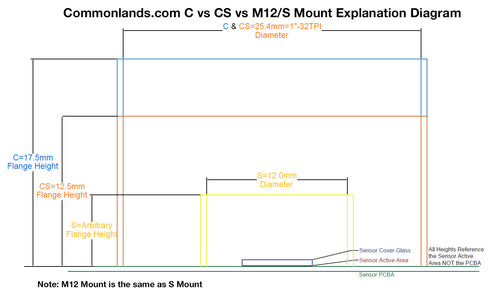카메라용 광학 렌즈: 이미지 캡처 뒤에 숨겨진 엔지니어링 기술을 탐구해보세요.
미국에 있는 엔지니어링 팀으로부터 카메라 광학 엔지니어링에 대해 자세히 알아보세요.
소니의 M12 렌즈와 같은 카메라 광학 렌즈는 대물렌즈라고도 합니다. 평면 볼록, 이중 볼록, 평면 오목, 이중 오목, 메니스커스, 비구면, 무색 이중 렌즈 등으로 구성된 다중 요소 광학 렌즈입니다. 광학 렌즈의 특성은 카메라에서 출력되는 이미지 품질에 영향을 미칩니다.
일련의 블로그 게시물에서는 이미징 광학의 엔지니어링 측면을 살펴봅니다. 임베디드 비전 카메라 시스템을 구축할 때 필요한 지각 지표와 고려 사항에 미치는 영향에 대해 설명합니다. 또한 관련 지표가 렌즈 선택에 영향을 미치기 때문에 이미지 품질이 컴퓨터 비전에 어떤 영향을 미치는지 조사합니다.
How to Focus an M12 (S‑Mount) or C‑Mount Lens: Engineer’s Setup Guide
If you've recently purchased one our M12 lenses or C-Mount lenses, the first step is to assemble your camera. We also offer camera module assembly services in quantities of >100.
자율 로봇, 감시 시스템 또는 기타 프로젝트용 카메라를 제작하는 경우 이미지 해상도 및 선명도는 임베디드 비전 시스템의 성능과 정확성에 큰 영향을 미칠 수 있습니다. 그렇기 때문에 카메라 렌즈 초점을 맞추는 방법을 이해하는 것은 모든 로봇 공학 엔지니어 또는 카메라 애호가에게 필수적인 기술입니다. 본 가이드에서는 카메라 렌즈에 완벽하게 초점을 맞추는 데 도움이 되는 기술, 도구 및 모범 사례를 제공합니다.


M12 렌즈란 무엇입니까?
카메라 렌즈를 청소하는 방법
렌즈 또는 이미지 센서를 청소하는 가장 좋은 방법에 대해 궁금한 적이 있으신가요? 이 문서에서는 더러운 렌즈와 센서의 영향에 대해 알아봅니다.
다음으로 광학 장비 세척을 위한 모범 사례와 도구에 대해 논의합니다.


Camera CMOS Sensor Size Guide: Understanding Image Sensor Format Types
디지털 카메라의 센서 포맷 크기와 픽셀 크기는 카메라의 여러 성능 속성에 영향을 미칩니다.
The format type of a digital camera sensor is one of the most confusing concepts in the vision industry.
렌즈 주 광선 각도 및 불일치
The chief ray angle (CRA) of a lens and the chief ray of a sensor affect image quality factors such as color shading and vignetting.


해상도 101

광각 렌즈 및 어안 카메라 렌즈 왜곡
광학 왜곡은 3차 횡수차입니다. 간단히 설명하자면 왜곡은 이미지 높이에 따른 배율(각 분해능)의 변화입니다.
GoPro의 마케팅 팀은 첫 번째 제품이 크롭 어안 렌즈를 사용했기 때문에 '어안'이라는 단어에 집착했습니다. 최신 GoPro는 어안 렌즈가 아닌 광각 렌즈를 사용합니다.
CCTV/CMOS 렌즈 마운트 유형 개요
맥스 헨카트
금 7월 24일 2020
비전 시스템 설계를 할 때 피할 수 없이 가장 먼저 묻는 질문 중 하나는 다음과 같습니다.
- CS 마운트 렌즈가 C 카메라 마운트와 호환되나요?
- C 마운트 렌즈가 CS 카메라 마운트와 호환되나요?
- S 마운트 렌즈와 M12 렌즈의 차이점은 무엇인가요?


라즈베리 파이 화상 회의
이미지 품질 서밋
본 게시물에서는 12가지 이상의 이미지 품질 지표와 컴퓨터 비전에 미치는 영향에 대해 살펴봅니다. 블로그 게시물과 비디오는 Max H가 Embedded Vision Summit 2022에서 진행한 강연에서 발췌했습니다.
- 카메라 노출 및 컴퓨터 비전
- 모션 블러
- 높은 다이나믹 레인지
- 해상도 및 선명도
- 음영 및 비네팅
- 노이즈
- 어안 왜곡 및 광각 렌즈
- 프린징 및 색수차


